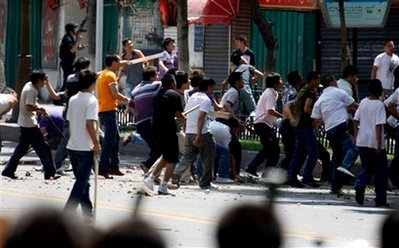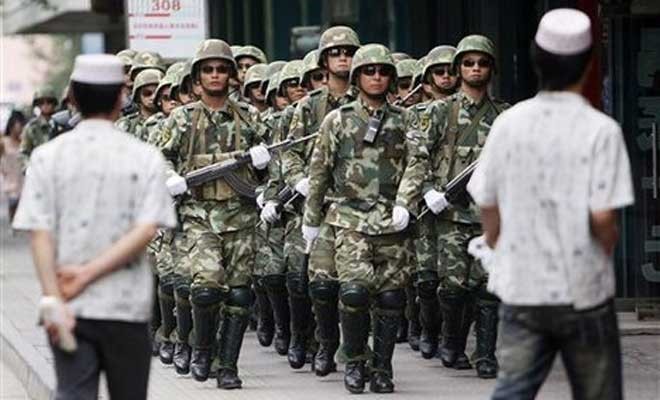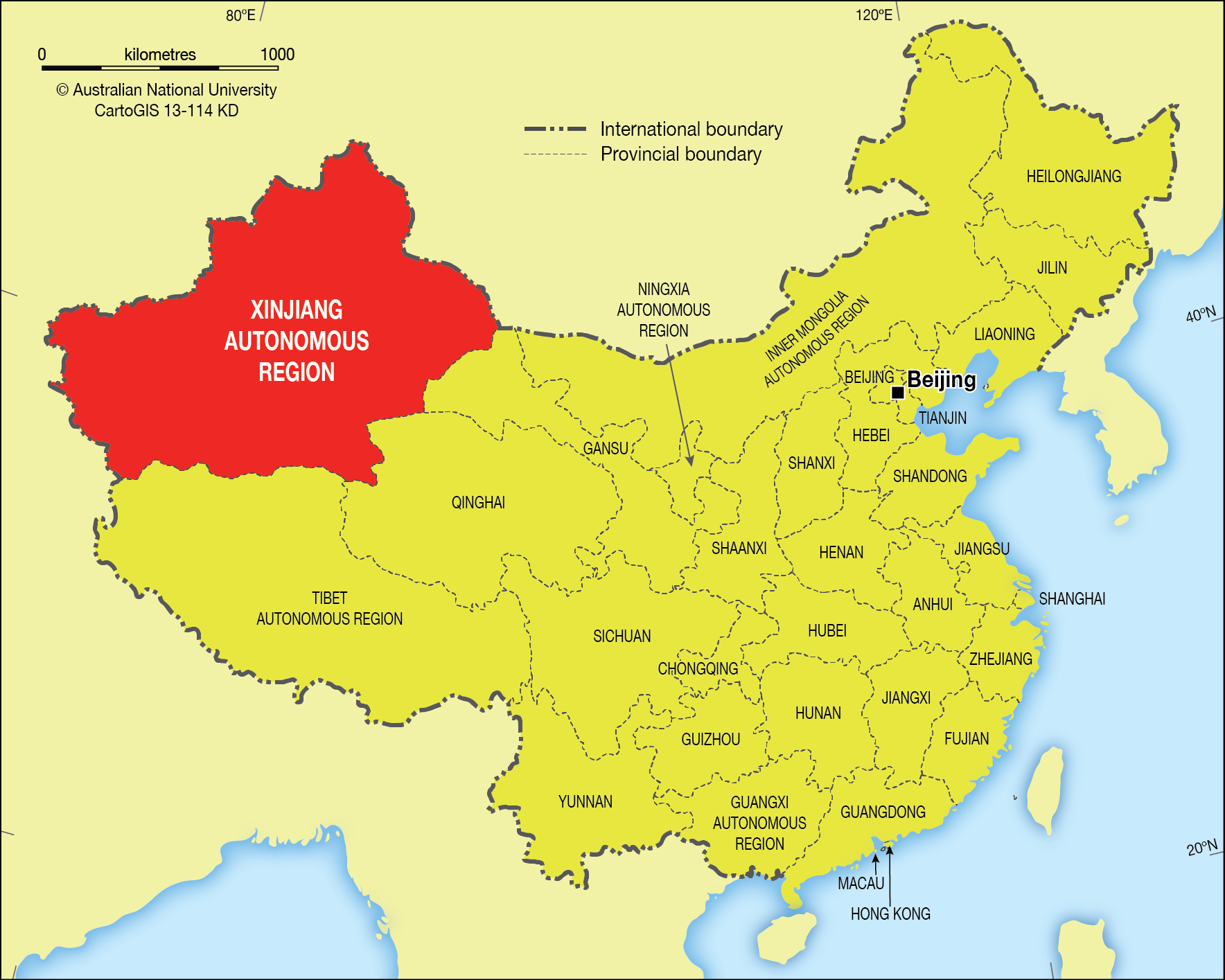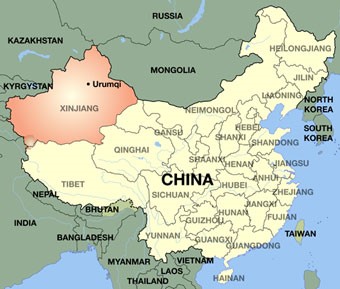Andrew McGregor
March 11, 2010
Though it appears to have occurred on February 15, the death of the leader of al-Hizb al-Islami al-Turkistani (Turkistani Islamic Party – TIP) was reported only in recent days (Geo TV, March 1; Dawn [Karachi], March 1; The News [Islamabad], March 2). Abdul Haq al-Turkistani was one of three militants killed by a missile launched from a CIA-operated unmanned aerial vehicle (UAV).
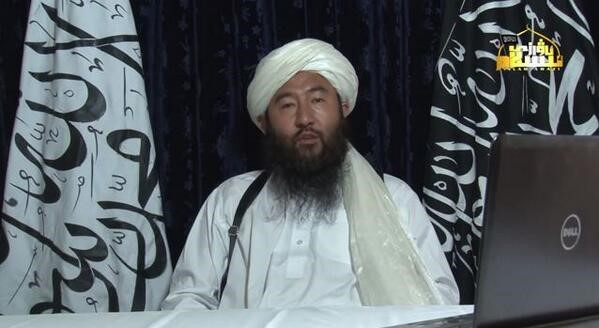 Late TIP Leader Abdul Haq al-Turkistani
Late TIP Leader Abdul Haq al-Turkistani
The men were reported to have been in a vehicle near the village of Tappi in the North Waziristan district of Miramshah. While the strike took place on February 15, Pakistani security officials did not release the news until March 1. The death of the leader of the radical Uyghur group was confirmed by a Taliban spokesman (Dawn [Karachi], March 1). Eastern Turkistan was occupied by troops of the People’s Liberation Army (PLA) in 1949 and the subsequent mass migration of non-Muslim Han Chinese to the renamed province of Xinjiang (New Territory) has rendered the native Turkic Muslim Uyghurs a minority in the region.
Despite the amount of international attention the TIP garnered through threats to the 2009 Beijing Olympics, the group’s relative inactivity and proclivity for claiming responsibility for incidents they clearly had nothing to do with raises questions about the very existence of the TIP as an active jihadi front.
Is the TIP the same as ETIM?
Many commentators seem happy to repeat Beijing’s assertion that the TIP is a new manifestation of the earlier East Turkistan Islamic Movement (ETIM), but no evidence has been provided to prove a direct link between the two groups. The ETIM never issued a statement regarding a change of name or organizational restructuring. Indeed, the ETIM seems to have faded out with a whimper rather than a bang after the death of its leader, Hasan Mahsum (a.k.a. Hasan Makhdum; a.k.a. Abu Muhammad al-Turkistani) at the hands of Pakistani security forces in 2003. [1] The uncertain origins of the ETIM’s so-called successor group, the TIP, have led to speculation that the TIP may be a splinter group of the ETIM or even a false-flag operation designed to establish ties between Uyghur separatists and al-Qaeda. TIP literature tries to establish a pedigree for the organization by substituting the TIP moniker for the ETIM name in descriptions of Hassan Mahsum’s earlier organization in Afghanistan (see the TIP eulogy of Hasan Mahsum, Shumukh al-Islam Network Forum, April 1, 2009). The traditional Muslim name of the Uyghur homeland is “East Turkistan,” not simply “Turkistan,” which refers to a much larger physical area of Central Asia. Xinjiang (New Territory) is a Chinese name and is never used by Uyghur opposition groups.
Although the TIP was unknown before it began issuing threats of biological, chemical and conventional attacks on the Beijing Olympics in 2008, Abdul Haq claimed the movement began as part of the military wing of the Islamic Movement of Uzbekistan (IMU) under the late Uzbek jihadi commander, Juma Namangani (killed in a U.S. aerial bombardment in November 2001). Uyghurs were present at IMU training camps in Afghanistan prior to 9/11.
Under the name Memtimin Memet (or Memetiming Memeti), Abdul Haq was identified in 2008 by China’s Ministry of Public Security as the successor of Hasan Mahsum and next leader of the ETIM (Xinhua, October 21). The statement, which named eight wanted Uyghur militants in connection with plots against the Olympics, made no mention of the TIP. The Ministry maintained that all of the Uyghur plots had been foiled by Chinese security forces. Though a series of bombings and attacks occurred in Xinjiang in August 2009, none were related to the Olympics (except through timing) and no claim of responsibility was issued by the TIP or ETIM. It is possible that the attacks were inspired by TIP videos, but this link has never been confirmed.
Tying Uyghur Militants to al-Qaeda
ETIM leader Hassan Mahsum always denied any connection between the ETIM and al-Qaeda, though there is no question a small group of Uyghur militants fought alongside their Taliban hosts against the Northern Alliance. According to China’s Foreign Ministry, the ETIM was a “terrorist organization with links to al-Qaeda,” but the scores of terrorists Beijing claimed that Bin Laden was sending to China in 2002 never materialized (China-Embassy.org, December 9, 2002). Likewise, the training and financial assistance that the U.S. State Department maintains al-Qaeda provided to the ETIM seems to have had little impact on ETIM’s inability to mount operations of any significance in China. The TIP’s “strategy” of making loud and alarming threats (attacks on the Olympics, use of biological and chemical weapons, etc.) without any operational follow-up has been enormously effective in promoting China’s efforts to characterize Uyghur separatists as “terrorists” with almost no material loss to China.
A videotaped biography of Hassan Makhdum carried by jihadi websites in 2009 claimed that “the leaders of the Turkistan Islamic Party nominated a new military leader, brother Abdul Haq, by consensus” to replace Hassan Makhdum after his death in 2003 (Shumukh al-Islam Network Forum, April 1, 2009). Despite his alleged role as leader of the al-Qaeda and Taliban-associated ETIM (or TIP) since 2003, Abdul Haq did not find his way onto the U.N. and U.S. Treasury Departments’ lists of terrorists “associated with Osama bin Laden, al-Qaeda or the Taliban” until April 2009. [2] Where was Abdul Haq between 2001 and 2008? He is known to have been an instructor at IMU training camps in Afghanistan before 9/11, but disappears from the record until his sudden reemergence as leader of the TIP in 2008.
An ambitious and no doubt expensive media campaign including internet magazines and video productions has little counterpart in actual TIP operations. Through articles in its internet journal, TIP appears to claim the mantle of Hasan Mahsum’s ETIM. Many of these articles appear to be an attempt to create an organizational connection between the TIP and the earlier ETIM, going so far as to retroactively rename the ETIM. Despite this, there is a chronological gap between the apparent demise of the ETIM, with the death of its leader in 2003, and the sudden emergence of the TIP in 2008. A few very minor militant actions in this period were attributed to the ETIM, though by this time Chinese authorities were using “ETIM” as an all-purpose descriptor for those responsible for any militant activity. There are scores of different Uyghur nationalist groups, which run the gamut from peaceful secularists to militant Islamist jihadis.
Promoting a Lost Cause in Xinjiang?
A video released in August, 2009 by the TIP’s own “Voice of Islam” media center and al-Fajr media center featured Abdul Haq and a number of TIP leaders discussing their jihad against “Chinese colonialism.” The video has an Arabic translation of the original Uyghur language remarks by the TIP leaders. A look at some of the leaders’ rhetoric shows a movement at odds with its time; its anti-communism decades too late to interest the West; its stated affinity to global jihad winning it no friends while doing nothing to actually further the cause of global jihad; their armed nationalism out of touch with young Uyghurs educated in Chinese and ready to seek economic opportunity at the expense of nationalist pride; and threats of terrorism not even winning them the head-pats given to Tibetan nationalists in an age of global economic integration in which China is a major player. Taking on China’s massive military on its own turf is also unlikely to make any priority list for global jihadists engaged in bitter struggles over South Asia and the Middle East. The following video excerpts give some indication of the stated motivation of the TIP:
Shaykh Uthman Umar Haji: “When we ask the Chinese people about the reason that brought them to our country, they say: ‘Turkistan is our land, it is a part of the Republic of China’… The Chinese are cowards and they fear death, but they did not find anyone to confront them and stop their march against Islamic East Turkistan. The Muslims will see how the Chinese Army will flee and leave Turkistan and its people alone… What good comes to a man who lives under the Chinese colonies like an animal? It is really shameful for us to be enslaved by China and accept humiliation and deprivation as an alternative to carrying out Islamic rulings in all aspects of our lives.”
Shaykh Abdul Haq: “The Chinese people are forcing the Muslims to achieve complete apostasy under the slogan of ‘The law is above all.’ They are forcing Muslim children to learn the Communist doctrine and they are afraid that the mujahideen influence the youth. When the Chinese could not apply an idea, they start to distort the image of the mujahideen and jihad through the media. They wanted the Muslims not to wake up from their long slumber and not to be able to recognize their sons, the mujahideen, or to realize the reality of the Communist campaign.”
Shaykh Abdullah Mansur: “We have to conquer our own country and purify it of all infidels. Then, we should conquer the infidels’ countries and spread Islam. The infidels who are usurping our countries have announced war against Islam and Muslims, forcing Muslims to abandon Islam and change their beliefs.” [3]
Among the TIP’s main complaints are government restrictions on the number of children, the demolition of historical Muslim urban areas and the imposition of equality between men and women “in rights and duties” by the communist regime.
Struggling with the Chinese Behemoth
The apparent hopelessness of a military struggle against China was addressed by Commander Abdullah Mansur, who drew on the communists’ own experience:
The Communist Chinese knew the power and effectiveness of weapons more than us, because they practiced fighting before and reached this level. The Communist Red Army was not formed or assembled overnight, but they were formed one individual after the other until it became a massive army. When they started fighting against Japan and their allies, they fought without tanks or warplanes. However, they managed to deter the Japanese and expel them from their lands in spite of the fact that their enemy was equipped with tanks and warplanes… We can say that confronting the Chinese enemy does not require possessing thousands of warplanes and tanks or thousands of soldiers, but it requires the first condition, which is faith in Almighty God and working according to His commands concerning preparation and jihad. [4]
Following the July 2009 riots in Urumqi that saw the loss of nearly 200 lives, Abdul Haq “appeared” (his face was digitally blurred) in a video urging Uyghurs and other Muslims to broaden the violence. “[The Chinese] must be targeted both at home and abroad. Their embassies, consulates, centers and gathering places should be targeted. Their men should be killed and captured to seek the release of our brothers who are jailed in Eastern Turkistan.” (Voice of Islam; July 31; Reuters, August 1, 2009; The Standard [Hong Kong], August 3, 2009). Despite Abdul Haq’s claim that “all the Islamic umma, especially the mujahideen in the world, are entirely ready to fight with their Muslim brothers in East Turkistan against the Chinese,” there were no takers in the jihadi community and the TIP again failed to follow words with operations.
Rioting in Urumqi, 2009
Having sentenced 26 people to death for their role in the Urumqi riots, China has now declared public security funding would be doubled for 2010 (al-Jazeera, January 28). Beijing has also announced plans to recruit 5,000 new special police officers to deal with unrest in Xinjiang. After a month of training, these new officers will serve in mixedunits with police from other parts of China (al-Jazeera, February 5). The security initiatives and additional spending suggest Beijing views 2010 as an opportunity to crush Uyghur separatism.
What was behind the decision to target Abdul Haq?
The United States designated the ETIM a terrorist organization in August 2002 after intense diplomatic pressure from China at a time when Washington was trying to prevent a Chinese veto at the U.N. over action against Iraq. The designation also followed a pledge by China to restrict missile technology transfers to nations like Iran. Though Uyghur militants had never targeted U.S. nationals or interests, the arrest of two Uyghurs in the Kyrgyzstan capital of Bishkek in May 2002 became the justification for Washington’s action. The Uyghurs were alleged to have a map of the capital’s embassy district in their possession. This was quickly transformed into a plot to bomb the U.S. embassy and the men were deported to China, never to be heard from again. This incident is still used as “proof” of a Uyghur threat to America.
Amir Mir, a Pakistani journalist and security analyst who is usually well-informed on defense matters, said discussions with diplomats in Islamabad suggested China was pressing Pakistan for the right to conduct its own military operations against Uyghur militants in FATA and the NWFP, similar to American operations in the region (The News, March 3). The CIA and the U.S. government do not comment on the process used in targeting attacks by UAVs in Pakistan, but there is wide speculation that Islamabad has negotiated a say in identifying targets on its territory in return for allowing U.S. drone operations to continue. Pakistan has no interest in antagonizing China, a major economic and military partner, and may have called for a strike on the TIP leader to relieve intense pressure from Beijing to do something about Uyghur militants in northwest Pakistan.
Following the strike on Abdul Haq, Pakistan’s Foreign Minister travelled to Beijing to convince China of Pakistan’s sincerity in ridding the frontier region of TIP members and other Uyghur militants. On March 7, Chinese Foreign Minister Yang Jiechi expressed satisfaction with Pakistan’s efforts; “I believe the government of Pakistan has effective control over the situation” (The Hindu, March 8).
Hasan Mahsum’s ETIM appears to have collapsed following his death in 2003. With the security forces of Pakistan, China and the United States aligned against it, it remains to be seen if the more “virtual” TIP will survive the death of Abdul Haq al-Turkistani.
Notes
1. See Andrew McGregor, “Chinese Counter-Terrorist Strike in Xinjiang,” Johns Hopkins University Central Asia – Caucasus Institute Central Asia Caucasus Analyst (March 7, 2007), www.cacianalyst.org/view_article.php
2. U.S. Department of the Treasury Press Release TG-92, April 20, 2009, www.ustreas.gov/press/releases/tg92.htm
3. Excerpts from “The Duty of Faith and Support,” Voice of Islam/al-Fajr Media Center, August 26, 2009.
4. Ibid
This article first appeared in the March 11, 2010 issue of the Jamestown Foundation’s Terrorism Monitor

